Artificial intelligence (AI) is changing and revolutionizing how we think about agriculture. AI offers new and innovative solutions that help farmers enhance yields, cut expenses, and increase efficiency, from precision farming to crop monitoring. Agriculture is one of the oldest industries in the world. It’s also one of the world’s major industries. Unsurprisingly, AI is finding a home in the agricultural world. While there are a lot of practical applications for AI in agriculture, it’s important to understand how the technology can be used.
AI plays a significant role in all industrial sectors, and the agriculture industry is no different. From smart farming to autonomous vehicles, AI is changing how we look at farming. In this blog article, we’ll look at the ten most practical applications of artificial intelligence in agriculture that are already being used, or have the potential to be used, to enhance the way we cultivate and produce food. Let’s check the top 10 practical applications of AI in Agriculture.
What is AI?
AI replicates human intelligence in computers trained to think and learn like humans. It entails using algorithms and statistical models to let computers execute activities that ordinarily need human intellect, such as visual perception, speech recognition, decision-making, and language translation.
There are two sorts of artificial intelligence: narrow or weak AI, meant to execute a specific task, and general or strong AI, which can accomplish any intellectual work that a human can. Artificial intelligence (AI) is constantly changing and advancing, thanks to breakthroughs in machine learning, natural language processing, and computer vision.
What is AI in Agriculture?
AI in agriculture refers to using artificial intelligence technology in the farming and food production industries. It can include various applications, such as precision farming, crop monitoring, livestock monitoring, weather forecasting, yield prediction, autonomous equipment operation, and more. The goal of AI in agriculture is to improve efficiency, increase yields, and reduce costs while also helping to ensure a sustainable food supply for the growing population.
When was AI first used in agriculture?
The application of artificial intelligence (AI) in agriculture has attracted the attention of researchers since the early days of AI research. The first known use of AI in agriculture dates back to the 1960s when researchers began investigating the use of computer vision and image processing to assess crop photographs.
The first successful application of AI in agriculture was the development of expert systems, which were computer programs that could mimic the decision-making process of human experts in agriculture. These expert systems were used in crop and soil management, pest control, and other areas of agriculture. In the 1980s, AI research in agriculture shifted towards machine learning and neural networks, which allowed for more accurate predictions and improved decision-making.
During this time, researchers began developing AI-powered systems for precision farming, which used data from sensors and cameras to provide farmers with real-time information about crop conditions. With the introduction of new technology and data availability in recent years, AI in agriculture has significantly developed and is now widely utilized for precision farming, crop monitoring, weather forecasting, yield prediction, autonomous equipment operation, and other applications.
10 practical applications of AI in agriculture
Precision farming applications of AI in agriculture
Precision farming is one of the most practical applications of artificial intelligence (AI) in agriculture. It refers to using technology to optimize farming practices and increase yields by using data from sensors and cameras to provide farmers with real-time information about crop conditions. Precision farming aims to improve efficiency, reduce costs, and increase yields by applying the right amount of water, fertilizer, and other resources at the right time. Some examples of AI-powered precision farming applications include:
- Crop Scouting: AI-powered systems can analyze crops’ images to identify issues such as pests, disease, or nutrient deficiencies. It can help farmers to take early action to prevent crop loss.
- Variable Rate Application: AI-powered systems can be used to analyze data on crop conditions, such as soil moisture and nutrient levels, to determine the optimal amount of fertilizer or pesticides to apply to specific field areas.
- Irrigation Management: AI-powered systems can optimize irrigation schedules by analyzing weather, soil moisture, and crop growth data to determine the best times to water crops.
- Autonomous Tractors: AI can control autonomous tractors, which can plant, cultivate, and harvest crops without a human operator. It can lead to increased efficiency and reduced labor costs.
In case you missed it: Precision Farming Tools – Guide For Beginners
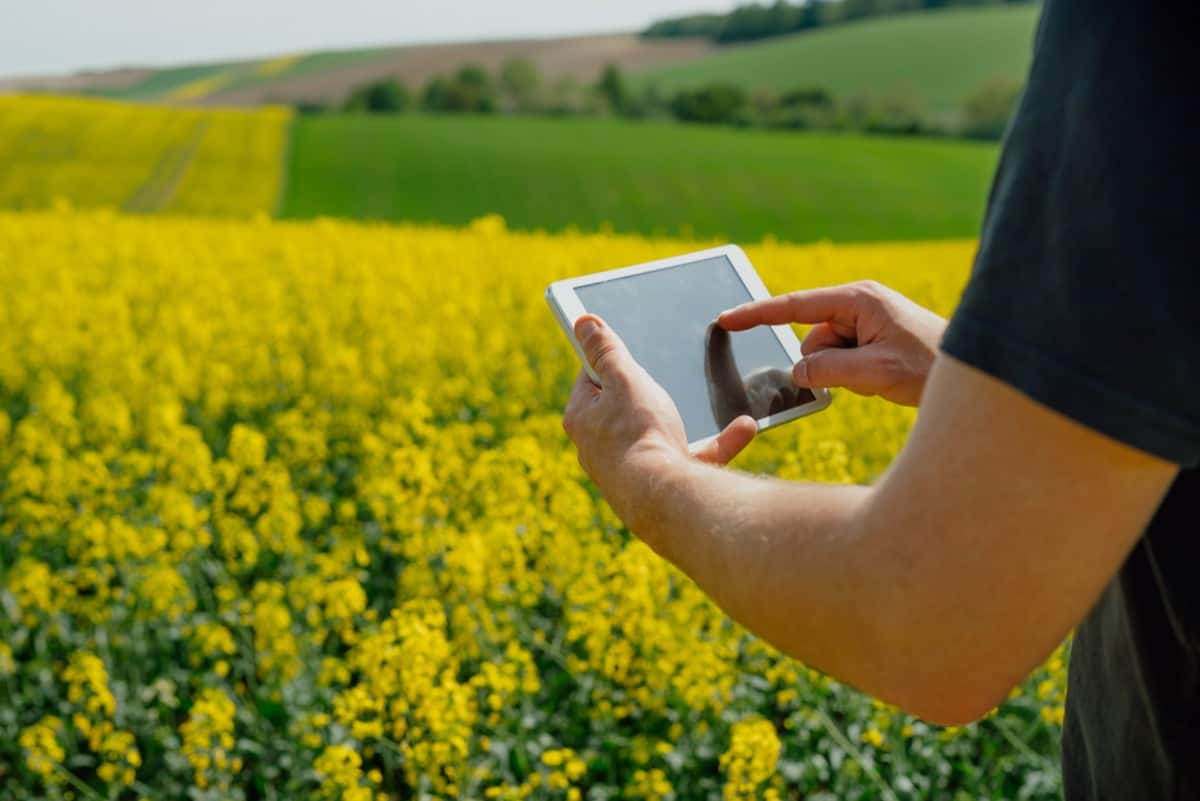
Predictive maintenance applications of AI in agriculture
Predictive maintenance is a strategy for maintaining equipment and systems that utilize data analytics, machine learning, and other artificial intelligence (AI) techniques to predict when equipment is likely to fail so that maintenance can be performed before the failure occurs. In agriculture, predictive maintenance can be applied to various equipment and systems, such as tractors, harvesters, irrigation systems, and other farm machinery.
By using data from sensors and other monitoring devices, predictive maintenance systems can analyze patterns and trends in the performance of the equipment to detect signs of impending failure. By detecting and addressing potential issues before they cause equipment failure, predictive maintenance can help in reducing the risk of accidents and injuries on the farm. Predictive maintenance can provide farmers with actionable data about their equipment, helping them decide when to schedule maintenance and manage their equipment.
Crop monitoring applications of AI in agriculture
Crop monitoring is the process of using technology to gather and analyze data about crop growth and health. This data can be used to estimate crop yields and reduce the risk of crop loss. Artificial intelligence (AI) can be used in crop monitoring to analyze large amounts of data and make predictions about crop growth and health. Some applications of AI in agriculture include:
- Crop disease detection: AI-powered cameras and drones can detect signs of crop disease, such as discoloration or wilting, in real-time.
- Crop growth monitoring: AI-powered cameras and sensors can monitor crop growth, providing farmers with detailed information on crop health, nutrient deficiencies, and water requirements.
- Crop water management: AI models can analyze data from weather stations and soil moisture sensors to optimize irrigation schedules, reducing water usage and increasing crop yields.
- Crop inventory management: AI models can analyze data from drones and cameras to create detailed crop inventories, providing farmers with information on crop health, crop yields, and crop distribution.
In case you missed it: Drip Fertigation in Vegetable Crops: A Practical Guide for Farmers
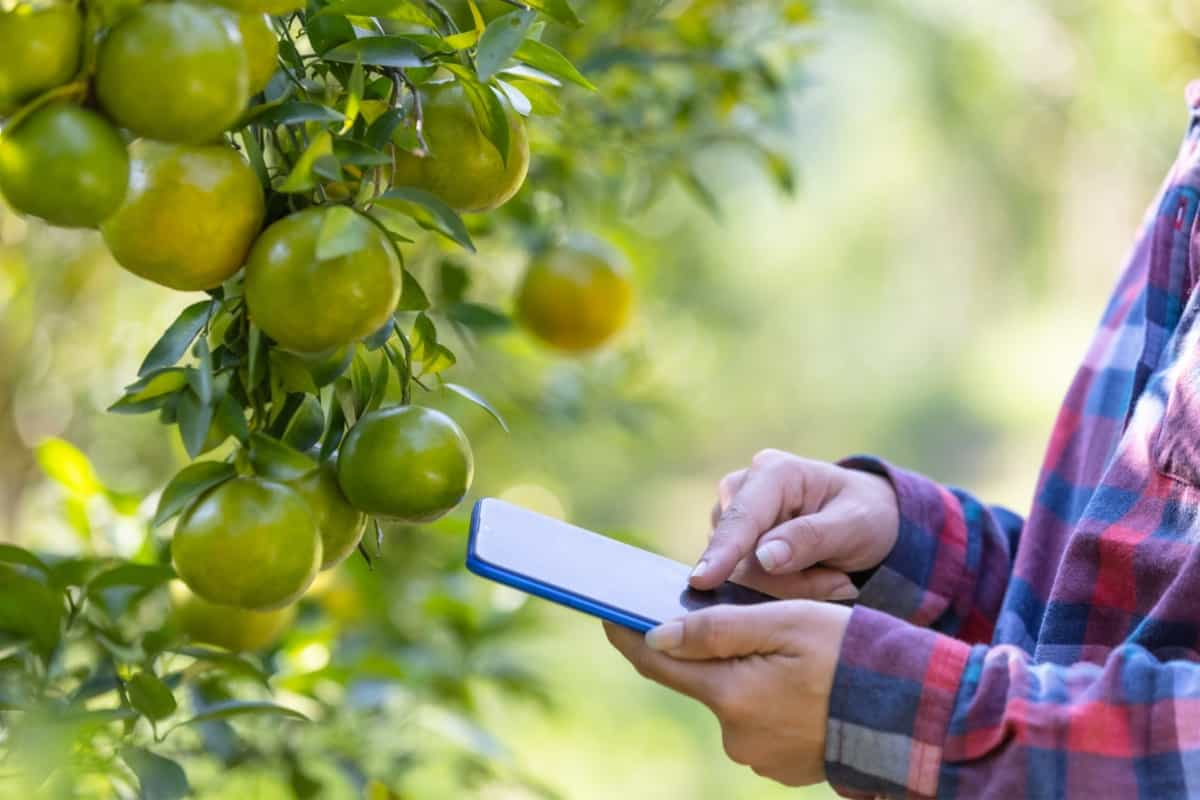
Livestock monitoring applications of AI in agriculture
Livestock monitoring applications of AI in agriculture involve using machine learning algorithms and other AI techniques to collect, analyze, and interpret data from various sources, such as cameras, sensors, and drones, to monitor the health and well-being of livestock. It can include monitoring for signs of disease, tracking the movement and behavior of animals, and identifying potential issues with feeding or breeding. These applications aim to improve the efficiency and productivity of livestock operations while also improving the welfare of the animals.
Weather forecasting applications of AI in Agriculture
AI approaches are used in weather forecasting applications in agriculture to analyze data from many sources, such as weather stations, satellites, and drones, to make precise and trustworthy forecasts about future weather patterns. Temperature, precipitation, wind speed and direction, and other meteorological variables affecting crop growth and development can all be forecasted.
It can include short-term forecasts for the next few days and long-term predictions for the next several weeks or months. The purpose of these applications is to provide accurate and fast weather information to farmers and other agricultural professionals so that they may make more informed decisions regarding planting, irrigation, and other vital tasks.
Yield prediction applications of AI in Agriculture
Yield prediction is the process of using artificial intelligence (AI) techniques to predict crop yields. It can be done by analyzing various factors that affect crop growth, such as weather data, soil conditions, and plant health. The goal is to provide farmers with accurate information about their crop yields to improve crop management and decision-making.
In case you missed it: Glasshouse Farming: For Increased Yields and Reduced Pesticide Use

Some applications of AI in agriculture include precision farming, which uses sensor data and machine learning to optimize crop yields and reduce costs, and crop monitoring, which uses drones and computers to gather data on crop health and growth patterns. Other applications include plant and crop breeding, which use machine learning algorithms to analyze genetic data and predict which crops will be most productive and resistant to disease.
Livestock robot applications of AI in agriculture
Livestock robots are robotic systems used to assist in caring for and managing livestock, such as cows, sheep, and pigs. These robots use artificial intelligence (AI) and other advanced technologies to perform tasks such as monitoring the health and behavior of animals, providing food and water, and cleaning and maintaining living areas. One of the main benefits of using AI in agriculture is that it can help improve farming operations’ efficiency and productivity.
Livestock robots, for example, can help farmers more effectively manage their herds by providing real-time data on the health and behavior of their animals. It can help farmers identify and address any issues more quickly, potentially reducing the risk of disease and increasing their animals’ overall health and well-being.
Another benefit of AI in agriculture is that it can help to reduce the labor costs associated with farming operations. Livestock robots, for example, can be programmed to perform routine tasks such as feeding and cleaning, freeing up farmers to focus on other essential aspects of their business.
Smart greenhouses applications of AI in agriculture
Smart greenhouses are greenhouses that use artificial intelligence (AI) to optimize plant growth and crop yields. It can be done by using sensors to monitor temperature, humidity, light levels, soil moisture, and other factors that affect plant growth.
In case you missed it: Key Rules to Start a Greenhouse Farming in Mexico: Business Plan, Setup Cost, Profit, and Management
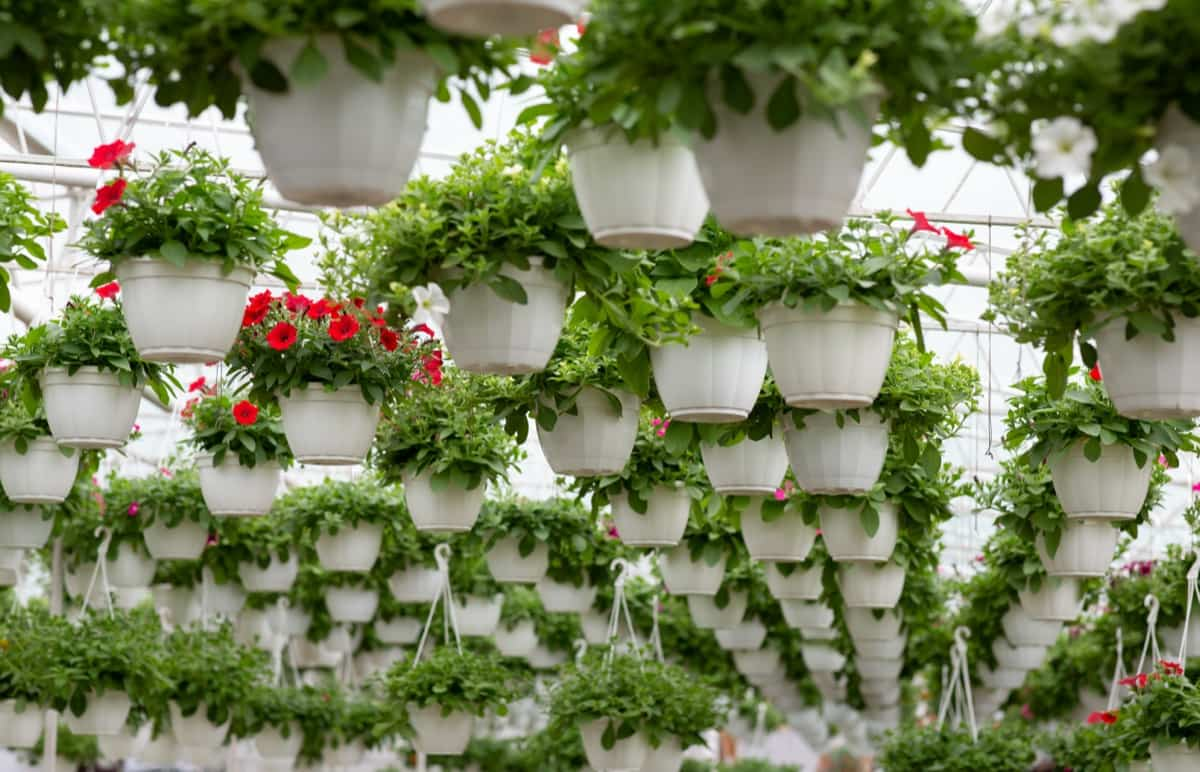
AI algorithms then analyze the data collected by the sensors to make adjustments to the greenhouse environment, such as adjusting the temperature or humidity, to optimize conditions for the plants. Additionally, AI can predict crop yields, detect pests and diseases, and optimize irrigation and fertilization. These technologies can help farmers produce more food with fewer resources, increase efficiency and reduce costs.
Weed, pest & disease monitoring applications of AI in agriculture
Weed, pest, and disease monitoring in agriculture can use artificial intelligence (AI) to detect and diagnose crop problems. It can be done by using sensors and cameras to capture images of the crops and analyze the images using AI algorithms. The AI algorithms can detect weeds, pests, and diseases by analyzing the images for specific patterns, such as the shape and color of leaves, the presence of pests, or disease symptoms. The benefits of using AI for weed, pest, and disease monitoring in agriculture include the following:
- Increased efficiency: AI can quickly and accurately detect and diagnose problems, which allows farmers to take action sooner and more effectively.
- Reduced costs: By detecting and diagnosing problems early, AI can help farmers use fewer resources, such as pesticides, and reduce crop losses.
- Increased crop yields: By identifying and treating problems early, AI can help increase crop yields and improve the overall health of the crops.
- The better target application of agrochemicals: AI can help farmers target the application of agrochemicals to specific areas, reducing the overall use of chemicals and minimizing the negative impact on the environment.
- Predictive modeling: AI can use the data collected over time to predict possible issues and take preventive measures before they become a problem.
Drones applications of AI in Agriculture
Drones, also known as autonomous aerial vehicles (UAVs), can be configured with a number of sensors and cameras to collect data about crops and fields. The data collected can then be analyzed using AI algorithms to gain insights into crop health, growth patterns, and potential problems such as pests and diseases. Some benefits of using drones with AI in agriculture include the following:
- Improved crop monitoring: Drones equipped with multispectral cameras can capture images of crops that can be analyzed to detect early signs of stress, disease, or pests.
- Increased efficiency: Drones can cover large areas quickly and gather data that would be difficult or impossible to collect manually.
- Reduced costs: Drones can cover large areas quickly and gather data that would be difficult or impossible to collect manually, which can help farmers reduce costs.
- Precise application of fertilizers, pesticides, and irrigation: Drones can be equipped with sensors that detect the specific needs of crops, such as nutrient deficiencies, and then apply fertilizers, pesticides, or irrigation exactly where they are needed, which can help farmers reduce costs and increase efficiency.
- Mapping and survey: Drones can map and survey land and crops, which can help farmers plan crop rotation, select the best areas to plant and identify problem areas that need attention.
In case you missed it: A Guide to Understand Importance of Drones in Agriculture/Farming: Advantages, Applications, and Different Types
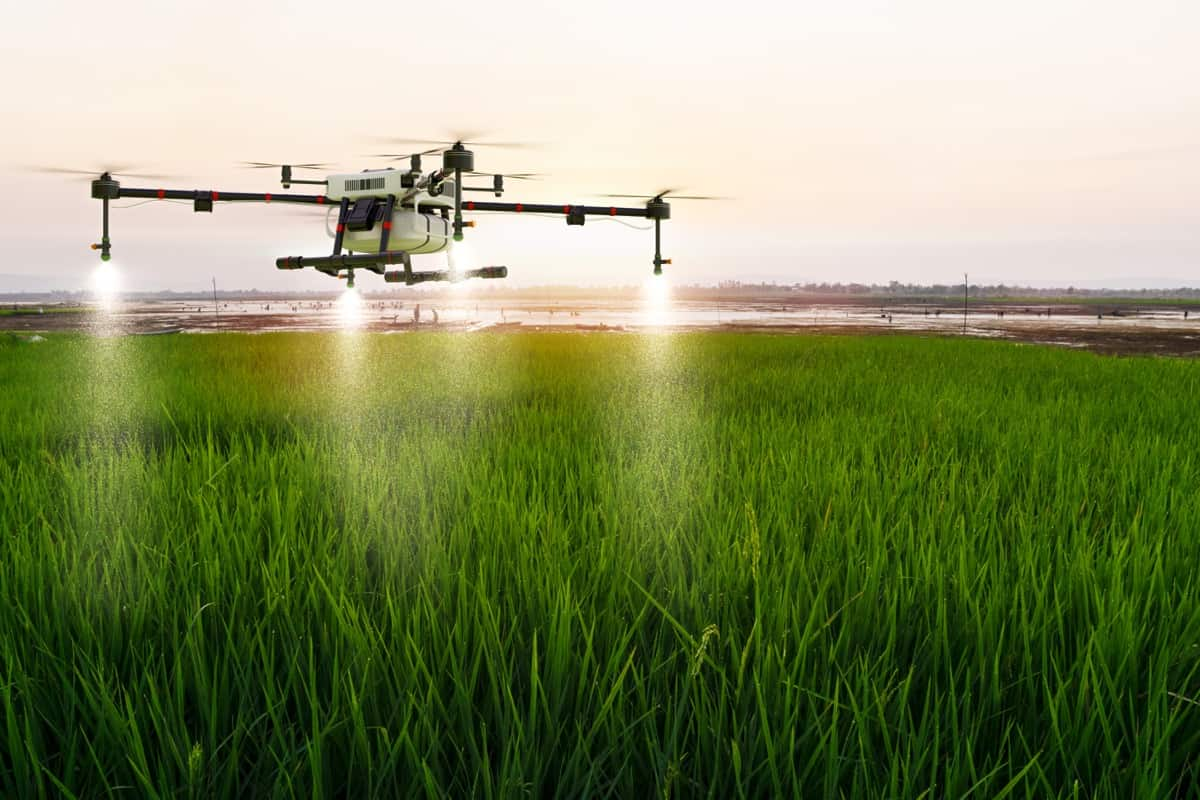
Other applications of Artificial Intelligence in Agriculture
- Water Management: AI-powered systems can optimize water usage in agriculture by analyzing weather, soil moisture, and crop growth data to determine the best times to water crops.
- Livestock Health Management: AI-powered systems can monitor livestock health by detecting early signs of disease and providing automated treatment recommendations.
- Soil Analysis: AI-powered systems can be used to analyze soil data, such as pH levels, nutrient content, and moisture levels, to help farmers optimize the health of their soil.
- Market Analysis: AI-powered systems can analyze market data; crop prices, for example, can help farmers decide what to plant and when to sell their crops.
Benefits of AI in agriculture
- Increased Efficiency: AI-powered systems can help farmers optimize planting and harvesting schedules and apply the right amount of water and fertilizer to crops. It can lead to increased yields and reduced costs.
- Improved Crop Maintenance: AI-powered systems can be used to gather data on crop growth and development, which can be used to identify problems, such as pests or diseases, early on. It allows farmers to take action before they become significant issues.
- Weather forecasting: AI analyzes weather data and provides farmers with more accurate and detailed weather forecasts. It can help farmers to plan for potential weather-related issues, such as frost or drought.
- Yield Estimation: This can help farmers plan for potential shortfalls and use resources better.
- Autonomous Equipment: AI-powered systems can control autonomous tractors, drones, or other equipment, which can plant, cultivate, and harvest crops without a human operator. It can lead to increased efficiency and reduced labor costs.
- Making Decisions: AI-powered systems can evaluate data and make decisions, allowing farmers to make more informed decisions about planting, harvesting, and other elements of farming.
- Labor-saving: AI-powered systems can automate specific farming tasks, which can help reduce labor costs and increase efficiency.
In case you missed it: Artificial Intelligence in Agriculture – Role, Benefits, and Examples
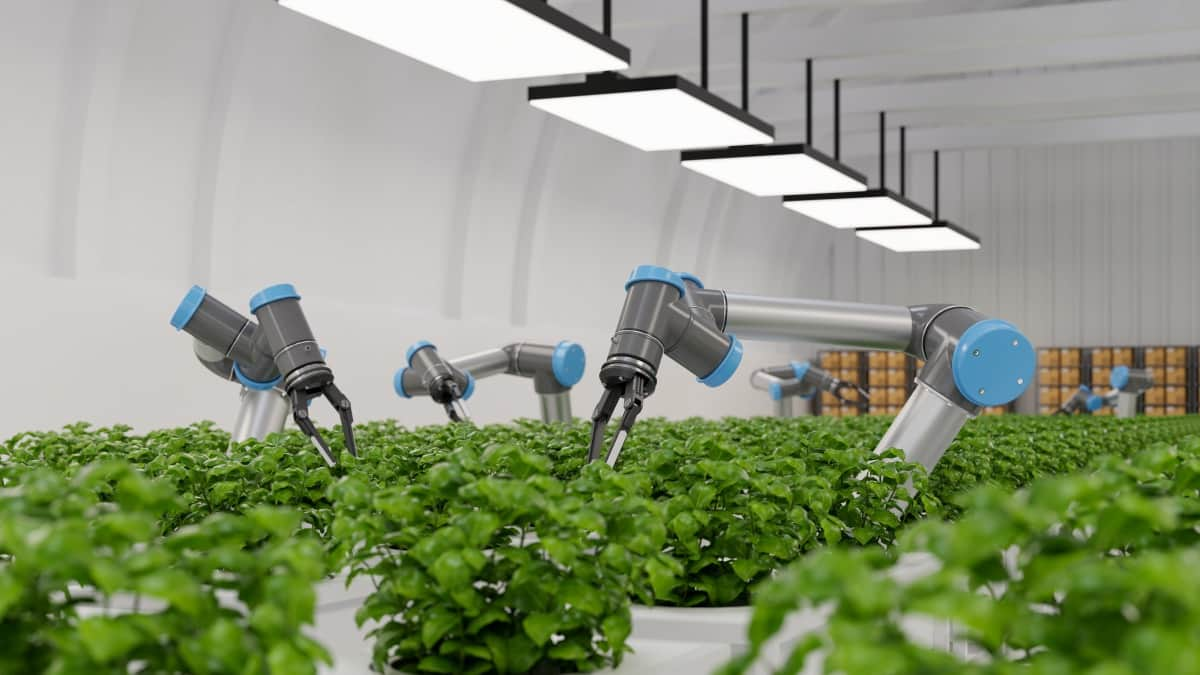
What is the future scenario of AI in Agriculture?
The future of AI in agriculture is expected to involve advanced technologies such as machine learning, computer vision, and drones to improve crop yields, optimize irrigation and fertilization, and monitor crop health. Additionally, AI is being used to create precision agriculture systems, optimizing planting and harvesting schedules based on weather and soil data and predicting crop yields and market prices.
Another focus is on automating farming tasks, such as planting, harvesting, and spraying, to reduce labor costs and increase efficiency. As these technologies continue to evolve, they will likely play an important role in the agricultural industry, helping to increase yields and reduce costs while also making farming more sustainable and efficient.
Conclusion
AI has the potential to revolutionize the agriculture industry by increasing efficiency and productivity through the use of technologies such as machine learning, computer vision, and drones. AI applications in agriculture include precision farming, crop monitoring, and automation of tasks such as planting and harvesting.
Additionally, AI can optimize irrigation and fertilization, predict crop yields and market prices, and make farming more sustainable and efficient. It can also be used to digitize agriculture and increase the yield of farmed acres. To get the full potential benefits of AI in agriculture, it is essential to use it with other tools and technologies to enhance traditional farming methods.
- Economical Aquaculture: A Guide to Low-Budget Fish Farming
- 15 Common Planting Errors That Can Doom Your Fruit Trees
- How to Make Houseplants Bushy: Effective Tips and Ideas
- Innovative Strategies for Boosting Coconut Pollination and Yield
- Pollination Strategies for Maximum Pumpkin Yield
- The Complete Guide to Chicken Fattening: Strategies for Maximum Growth
- Natural Solutions for Tulip Problems: 100% Effective Remedies for Leaf and Bulb-Related Issues
- Revolutionizing Citrus Preservation: Towards a Healthier, Greener Future
- Natural Solutions for Peony Leaf and Flower Problems: 100% Effective Remedies
- Maximizing Profits with Avocado Contract Farming in India: A Comprehensive Guide
- Natural Solutions for Hydrangea Problems: 100% Effective Remedies for Leaf and Flowers
- The Ultimate Guide to Choosing the Perfect Foliage Friend: Bringing Life Indoors
- From Sunlight to Sustainability: 15 Ways to Use Solar Technology in Agriculture
- The Ultimate Guide to Dong Tao Chicken: Exploring from History to Raising
- The Eco-Friendly Makeover: How to Convert Your Unused Swimming Pool into a Fish Pond
- Mastering the Art of Delaware Chicken Farming: Essentials for Healthy Backyard Flocks
- 20 Best Homemade Fertilizers for Money Plant: DIY Recipes and Application Methods
- How to Craft a Comprehensive Free-Range Chicken Farming Business Plan
- Brighten Your Flock: Raising Easter Egger Chickens for Beauty and Bounty
- How to Optimize Your Poultry Egg Farm Business Plan with These Strategies
- Subsidy for Spirulina Cultivation: How Indian Government Schemes Encouraging Spirulina Farmers
- Ultimate Guide to Raising Dominique Chickens: Breeding, Feeding, Egg-Production, and Care
- Mastering the Art of Raising Jersey Giant Chickens: Care, Feeding, and More
- Ultimate Guide to Raising Legbar Chickens: Breeding, Farming Practices, Diet, Egg-Production
- How to Raise Welsummer Chickens: A Comprehensive Guide for Beginners
- How to Protect Indoor Plants in Winter: A Comprehensive Guide
- Ultimate Guide to Grow Bag Gardening: Tips, Tricks, and Planting Ideas for Urban Gardeners
- Guide to Lotus Cultivation: How to Propagate, Plant, Grow, Care, Cost, and Profit
- Agriculture Drone Subsidy Scheme: Government Kisan Subsidy, License, and How to Apply Online
- Ultimate Guide to Raising Araucana Chickens: Breed Profile, Farming Economics, Diet, and Care
- Bringing Hydroponics to Classroom: Importance, Benefits of Learning for School Students
- Ultimate Guide to Raising Polish Chickens: Breed Profile, Farming Economics, Diet, and Care
- Ultimate Guide to Raising Australorp Chickens: Profile, Farming Economics, Egg Production, Diet, and Care
- Silkie Chicken Farming: Raising Practices, Varieties, Egg Production, Diet, and Care
- Sussex Chicken Farming: Raising Practices, Varieties, Egg Production, Diet and Care
- Homemade Feed Formulations for Livestock: Discover Cost-effective Starter to Finisher Feed Recipes